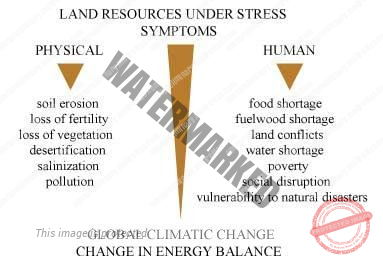- LAND RESOURCE
- THE CONCEPT OF LAND AND LAND USE
- CHALLENGES AND STRESS ON LAND RESOURCES
UNIT 7 – ENVIRONMENTAL POLLUTION – PART 3
LAND RESOURCE
Land is an essential natural resource, both for the survival and prosperity of humanity, and for the maintenance of all terrestrial ecosystems. Over millennia, people have exorbitantly exploited land resources for their own ends. The limits on these resources are finite while human demands on them are not. Increased demand, or pressure on land resources, shows up as declining crop production, degradation of land quality and quantity, and competition for land.
Attention should now be focused on the role of humankind as stewards rather than exploiters, charged with the responsibility of safeguarding the rights of unborn generations and of conserving land as the basis of the global ecosystem.
Land is not regarded simply in terms of soils and surface topography, but encompasses such features as underlying superficial deposits, climate and water resources, and also the plant and animal communities which have developed as a result of the interaction of these physical conditions.
The results of human activities, reflected by changes in vegetative cover or by structures, are also regarded as features of the land. Changing one of the factors, such as land use, has potential impacts on other factors, such as Flora And Fauna, Soils, Surface Water Distribution And Climate.
Changes in these factors can be readily explained by ecosystem dynamics and the importance of their relationships in planning and management of land resources has become increasingly evident.
THE CONCEPT OF LAND AND LAND USE
DEFINITIONS |
Land and Land Resources refer to a delineable area of the earth’s terrestrial surface, encompassing all attributes of the biosphere immediately above or below this surface, including those of the near-surface climate, the soil and terrain forms, the surface hydrology (including shallow lakes, rivers, marshes and swamps), the near-surface sedimentary layers and associated groundwater and geo hydrological reserve, the plant and animal populations, the human settlement pattern and physical results of past and present human activity (terracing, water storage or drainage structures, roads, buildings, etc.) (FAO/UNEP, 1997). Land Use is characterized by the arrangements, activities and inputs by people to produce change or maintain a certain land cover type. (Di Gregorio and Jansen, 1998). Land use defined in this way establishes a direct link between land cover and the actions of people in their environment. Land Cover is the observed (bio)physical cover on the earth’s surface (Di Gregorio and Jansen, 1998) |
In the terminology of environmental economics, land can be regarded as a stock renewable resource. Land resources do not easily fit into the categories of renewable or non-renewable. In general, they are slowly renewable; however, their rate of degradation far exceeds their natural rate of regeneration. In practical terms, this means that land that is lost to degradation is not naturally replaced within a human time frame, resulting in a loss of opportunities for the next generation.
THE BASIC RELATIONSHIP: LAND, POPULATION AND MANAGEMENT STRATEGIES
The potential production of arable land and its susceptibility to degradation are dependent on the management strategies employed and on inherent soil and other characteristics. In agriculture-dependant societies this combination of factors determines potentially the population that can be supported and the standard of living.
When population increases in a given area, the increased demand on production can induce stress and consequent degradation of the land resource. If no other source of income can be tapped (e.g. by migration to urban areas) people’s standards of living decrease.
However, if improved management strategies (including technologies) are available, either the standard of living may rise or more people can be supported at the same standard of living without deterioration of the natural resource base. It follows that an ample supply of land of suitable quality and appropriate production technologies are essential if the increasing demands of a growing population are to be met.
CHALLENGES AND STRESS ON LAND RESOURCES
Currently, land resources are clearly under stress; 16% of arable land is degraded and the percentage is increasing (FAO, 1997). Traditional systems of land management are either breaking down or are no longer appropriate.
The primary reason for this situation is the increasing demands placed on land by the unprecedented rate of population growth and the effects it induces. Externalities related to global change are also becoming a constraint to sustainable land management.

